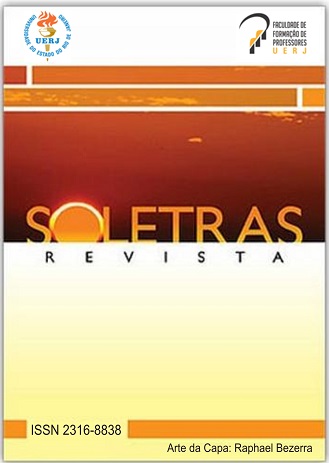‘“Be the One that Rescues You”: Contexts for the Construction of Agency in Kenneth Branagh’s “Cinderella”’
DOI:
https://doi.org/10.12957/soletras.2016.27186Resumo
While scholars agree that ‘Cinderella’ is the most widely known and best loved of all fairy tales, the difference between the number of variant written texts they estimate is astonishing. Saxby (1979) mentions the figure 600, De Vos and Altmann (1999) ‘more than 700’, and Heiner (2012) says there are ‘well over 1000 with a conservative estimate of over twice that…recorded.’ The range itself – particularly that cited by Heiner – is instructive. How few of the tropes can be present for a narrative to be recognised as a variant of ‘Cinderella’? Limiting his estimate to the medium of film, Zipes (2016:361) agrees that ‘Cinderella’ is the most popular of fairy tales and refers to ‘over 130’ film adaptations. How broadly he interprets ‘film’ is not clear, but the ‘over’ presumably suggests that the number would increase significantly if it included short television and internet parodies and narratives where Cinderella tropes were present but not explicit, for example in ‘reality’ television shows such as ‘The Bachelor’ and ‘Married at First Sight’. Why, then, would Walt Disney Studios add to this extensive field yet another major adaptation in the live-action ‘Cinderella’ (2015) directed by Kenneth Branagh?
Downloads
Publicado
Edição
Seção
Licença
A aprovação dos artigos implica a cessão imediata e sem ônus dos direitos de publicação nesta revista. O(s) autor(es) autoriza(m) ao Programa de Pós-graduação em Letras e Linguística (PPLIN) a reproduzi-lo e publicá-lo na revista SOLETRAS, entendendo-se os termos “reprodução” e “publicação” conforme definição do artigo 5° da Lei 9610/98. O(s) autor(es) continuará(rão) a ter os direitos autorais para publicações posteriores. O artigo poderá ser acessado pela rede mundial de computadores (http://www.e-publicacoes.uerj.br/index.php/soletras), sendo permitidas, a título gratuito, a consulta e a reprodução de exemplar do artigo para uso próprio de quem o consulta. Casos de plágio ou quaisquer ilegalidades nos textos apresentados são de inteira responsabilidade de seus autores.



